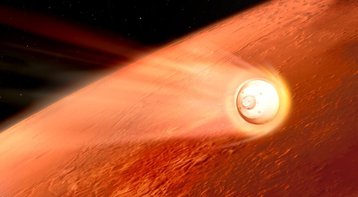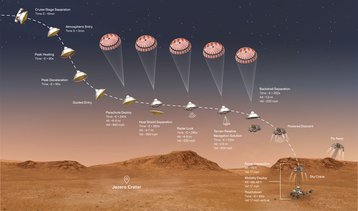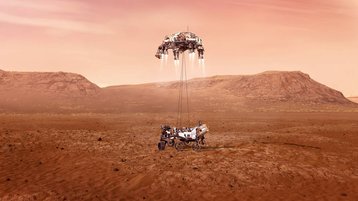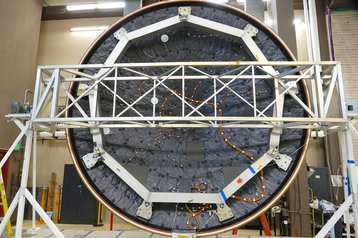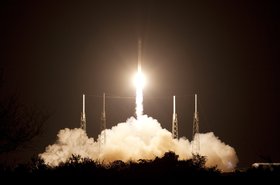As NASA's Mars 2020 expedition goes through a risky landing process today, sensors will be gathering data to reduce the uncertainty of future missions.
The Mars 2020 team at NASA will face the much-reported "seven minutes of terror" embodied by EDL (entry, descent, and landing) today as the probe enters Mar's atmosphere. The heatshield is designed to slow the craft, which carries the Perseverance rover, enough to deploy parachutes and land safely. For the first time, sensors in the shield and back shell will collect and store data, which will allow future designs to use less weight in the shield, and land in a smaller, more precise area.
Seven minutes of terrific data
The rover and its casing have taken six-and-a-half months to travel the 300 million miles to Mars and, assuming today's landing goes to plan, will begin to explore the planet's surface, seeking signs of ancient life and drilling rock samples which will be collected and could be returned to earth by a future "sample return" mission.
The Perseverance rover's protective aeroshell is carrying 28 sensors designed to measure extreme heat and pressure during the EDL, the riskiest part of the entire mission, which will be streamed live by NASA from 1415 EST today. The MEDLI2 sensor system (Mars Entry, Descent, and Landing Instrumentation 2) will relay data during the approach to Mars, and then collect and store data during the descent and landing to be analyzed for future missions.
MEDLI2 includes thermocouples, heat flux sensors, and pressure transducers, as well as all the electronics and hardware needed to record the heat and pressure experienced in the first four minutes of entry up till the parachute deploys, and the heatshield is discarded.
The sensors will provide more information about the unique heating events produced by the heat shield moving through the Martian atmosphere. In particular, they will chart the effect of the varying density of the atmosphere, and the effect of low-altitude winds on the flight path.
This will be the first time NASA will ever have direct heat measurements from a vehicle entering the Martian atmosphere, and the data will allow lighter heatshields to be designed in future - early estimates from the EDLI2 team predicted that the data could cut the mass of future heatshields by 35 percent.
Later in the descent, information about the effect of winds could help future probes land more precisely, reducing the landing footprint by around 30 percent. NASA has predicted a landing footprint for Perseverance which is 4.8 miles by 4.1 miles, already three times smaller than Curiosity's landing target of 15.5 x 12.4 miles (and massively smaller than the 120 x 60 mile barn door hit by Pathfinder in 1997).
The Mars mission team has already checked the MEDLI2 hardware and it is ready for today's EDL, according to comments in a NASA release, from Henry Wright, MEDLI2 project manager at NASA’s Langley Research Center in Hampton, Virginia: “Recent successful checkouts of our MEDLI2 hardware during the Mars 2020 cruise demonstrates that our system is performing as intended and has survived the initial round of harsh flight environments. We are eager for the successful EDL of Mars 2020!”
MEDLI2 will warm up five hours before entry, and will send "near real time" data as the vehicle coasts towards the Martian atmosphere. A subset of this data will be processed and assessed to support the final approach.
Then, with signals from Mars taking around 12 minutes to reach Earth, the EDL has to proceed automatically, but the EDLI2 will collect data continuously for future use, starting about 10 minutes before entry.
During the early part of entry, the vehicle will hit Mars atmosphere traveling at 12,500mph, and sensors should pick up a peak temperature of 1,200°C to 1,300°C. When the vehicle slows to supersonic flight, the pressure transducers will come into their own, looking for how winds buffet the craft. About four minutes into the descent, the parachute will deploy, MEDLI2 will power down, and the heat shield will be jettisoned, taking a lot of the MEDLI2 hardware with it.
At this point, radar will give a precise altitude. The rover's cameras will look for features on the ground, backed by on-board pattern recognition to pick the landing spot.
At 200mph, the parachute cuts loose, and the vehicle's rockets slow it down. When the vehicle is 20m from the surface, the rover will be lowered by cables for a soft landing.
During this phase, the remainder of MEDLI2 will continue to gather data.
“I am proud of the MEDLI2 team,” Wright said. “It isn’t easy developing new, one-of-a-kind space hardware, especially with a fixed delivery date. The team always remained focused on ensuring the MEDLI2 system will perform as intended, despite development setbacks and challenges introduced by the pandemic.”
Signal transport
Signals from the Mars misison are being sent back via the Mars Reconnaisanced Orbiter, which entered Mars orbit in 2006, and has been used as a data relay since the end of its mission in 2010. This relay means there's a possibility of photos taken by the rover itself arriving quite soon after landing.
Another orbiter, Odyssey, will pass over the landing site a few hours after the EDL, followed shortly by the European Space Agency’s ExoMars Trace Gas Orbiter, giving a chance to see how the landing went from external cameras.

